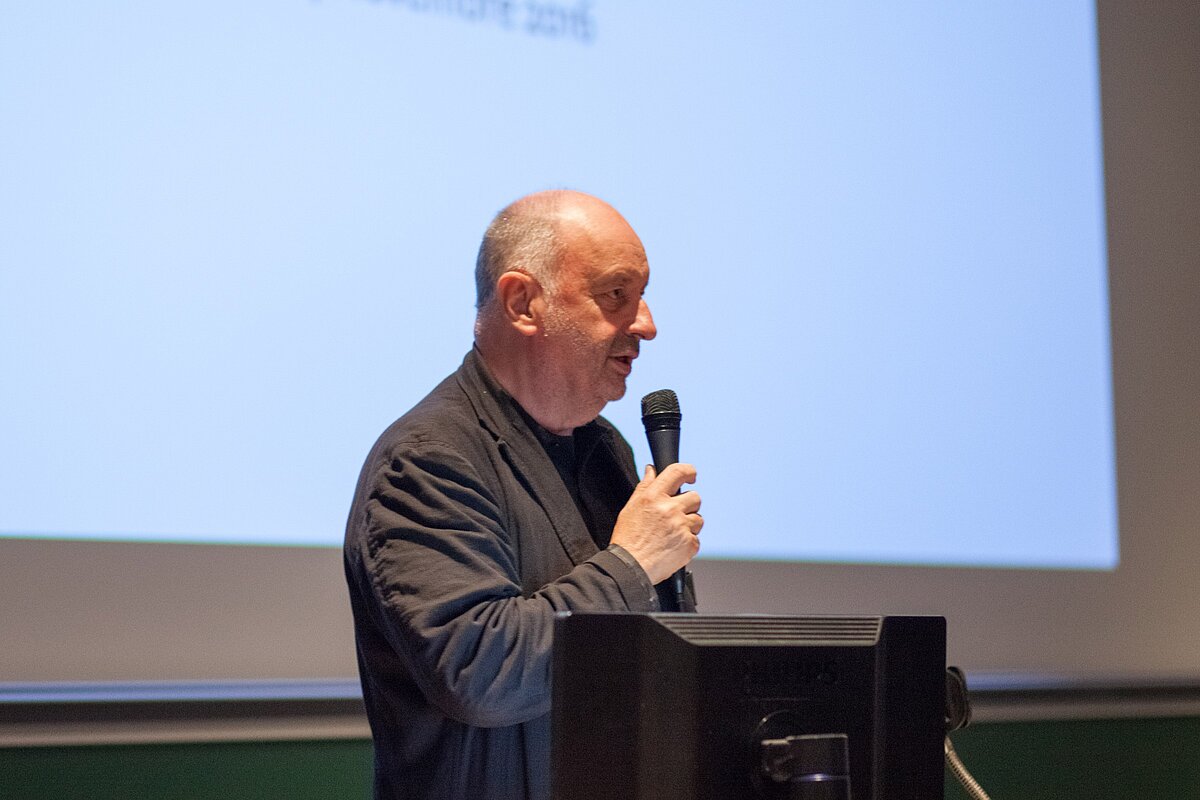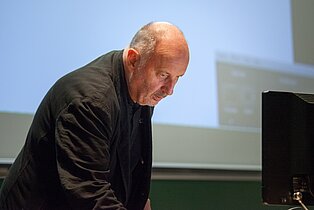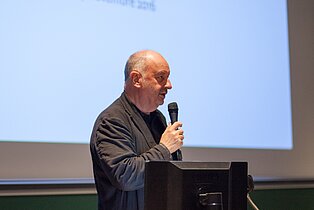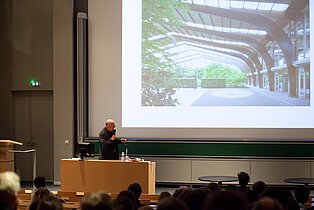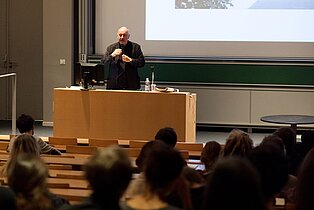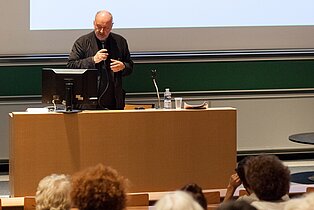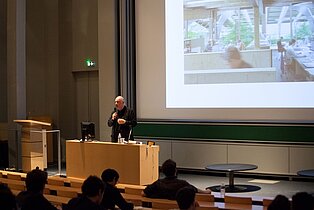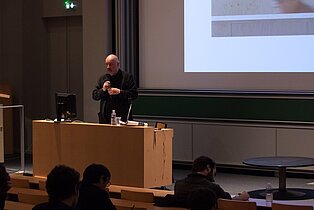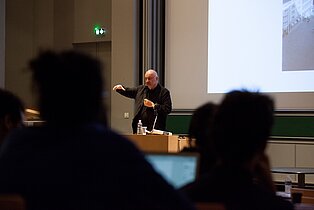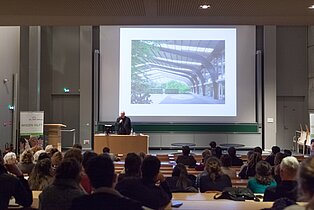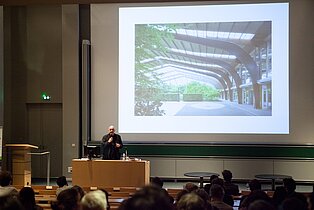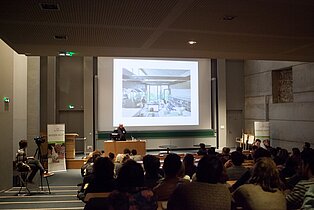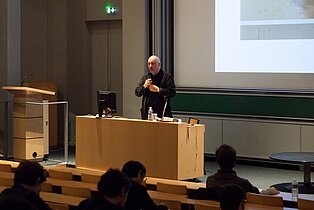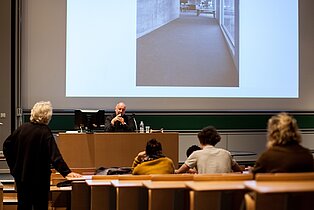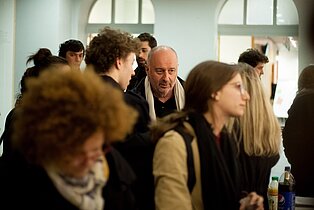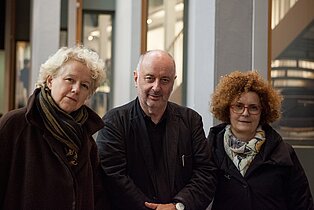Paul Robbrecht | Robbrecht en Daem Architecten | Gent
Paul Robbrecht: Designing elsewhere
Paul Robbrecht, who was born in 1950, founded the office Robbrecht with Hilde Daem in Ghent in 1975. They began their career with different orders from the elite of the Flemish scene (collectors, gallery owners, artists and sponsors) and built many cultural institutions (museums, art galleries, libraries and concert halls). In addition, they designed exhibition pavilions, the setups for various productions, furniture and multiple homes.
Unlike the previous two speakers (Emilio Tuñon und Marc Mimram), Paul Robbrecht did not say much about the problem of international projects “without identity”. In fact, most of his foreign projects can be found in Europe – primarily in countries bordering Belgium. Still, the topic of “elsewhere” is present in his body of work. Indeed, it seems that Robbrecht, because of the projects he has been entrusted with, has always been working on the idea of designing elsewhere. The process takes different forms – the creation of inwardness, a descent into the past, the invitation to go on a journey or the submergence in art. The architect shines when it comes to producing other spaces. Not heterotopic spaces but rather those whose differentness is found in their unique relationship to the context.
In order to design the “elsewhere” in his projects, Paul Robbrecht initially creates a pronounced inwardness. The primary focus of his architecture is that it is appreciated from the interior. Therefore, the mood of the rooms takes precedence over the exterior appearance of the building, which at times is strange and irritating , and the experience of visitors is more important than the look or the “concept” of the project. The clumsy weight of the roof of the archive building in Bordeaux, for example, might be shocking at first glance. However, once one is inside, the perceived space is revealed to be a thoroughly sensual experience because each detail – materials, light, temperature, humidity and acoustics – was meticulously planned by the architect.
The market hall in Ghent is primarily based on the goal to create urban intimacy in the heart of a public space. The first competition for the redesign of the space only provides for an increase of parking spots. The office, however, proposed the construction of a new building between the belfry and the cathedral. The idea was initially rejected but then included in the specifications for the second competition, which the office won. Its project does not achieve the creation of an urban interior by closing off the space, which is merely sectioned off with four large pillars that bear the weight of a massive roof sculpture, but rather by how residents use this space. A large fireplace at the bottom of one of the pillars gives pedestrians an opportunity to warm up at the fire. This mixture of comfort and intimacy gives the large, covered space a strangely homely character. This outmoded treatment of the public space also transports us into a chronological “elsewhere” – to an almost mythical time when the fireplace was a meeting place for the city.
The journey to a chronological “elsewhere” is also based on the design of Mies van der Rohe’s Golf Club House in Krefeld. This large-scale model is supposed to revive the spatial experience that Mies van der Rohe had intended for his customers – those young bourgeois Germans in the 1930s who assumed an air of Britishness by playing golf on Sundays. In 2009, in the restaurant of the art gallery and library of Whitechapel in London, Robbrecht once again manifested his desire to allow visitors to submerge – this time in a type of reconstruction of the original Art-and-Crafts atmosphere of the Victorian building. His intervention could be described as “changing everything to change nothing”.
Paul Robbrecht has also managed to give buildings a hint of the “elsewhere” that gives them the impression that they are about to move. In 1992, on the occasion of the 9th Documenta in Kassel, the architect built a series of pavilions with pilotis that are located in a corner of the immensely large park that is a part of the Fridericianum. Placed in a row, they undeniably elicit images of a marshalling yard because the pavilions are only a temporary feature. Robbrecht has designed them as a type of railway wagon, which reinforces the impression that this architecture is just temporary – passing through like the exhibited pieces of art. In this context, it was a daring metaphor because the association of moving trains could have opened the wounds of Germany’s trauma related to deportation. In the end, however, critics saw it as an invitation to go on a journey. Indeed, one loses all sense of space and time when strolling through the misty garden in between these boxes that seem to float above the ground – and an intimate connection between art and visitor is established.
Aesthetic submergence is undoubtedly the ultimate method Robbrecht uses to build the “elsewhere” into his projects. In fact, his exhibition rooms always create a fruitful connection to the pieces of art exhibited in them. They are definitely not simply a response to the requirements of the art, as the cooperation between Robbrecht, Daem and Gerhard Richter shows. In a Documenta pavilion, the architects and the artist jointly designed a nut wood-clad gallery to showcase the paintings Richter specifically created for this room. To the degree that contemporary art is aware of the environment and the artistic experience is all-encompassing, this aesthetic shift is expressed on an architectural level by Robbrecht’s phenomenological approach – from a purely visual appreciation toward the synesthetic experience of the senses (in the literal meaning of the word) of the room that physically surrounds visitors.
Using a range of subtle approaches, Paul Robbrecht managed to create different other places and, at the same time, hinted at a perception-related beyond that is both geographical and chronological in nature. These rooms, which play with the ambiguity of the “here” and “there”, stand out through their uniqueness and the fact that they cannot be reproduced, like an architectural hapax legomenon, in which the experience is also one-of-a-kind.
Video-Interview with Paul Robbrecht
Visit our YouTube-Channel


